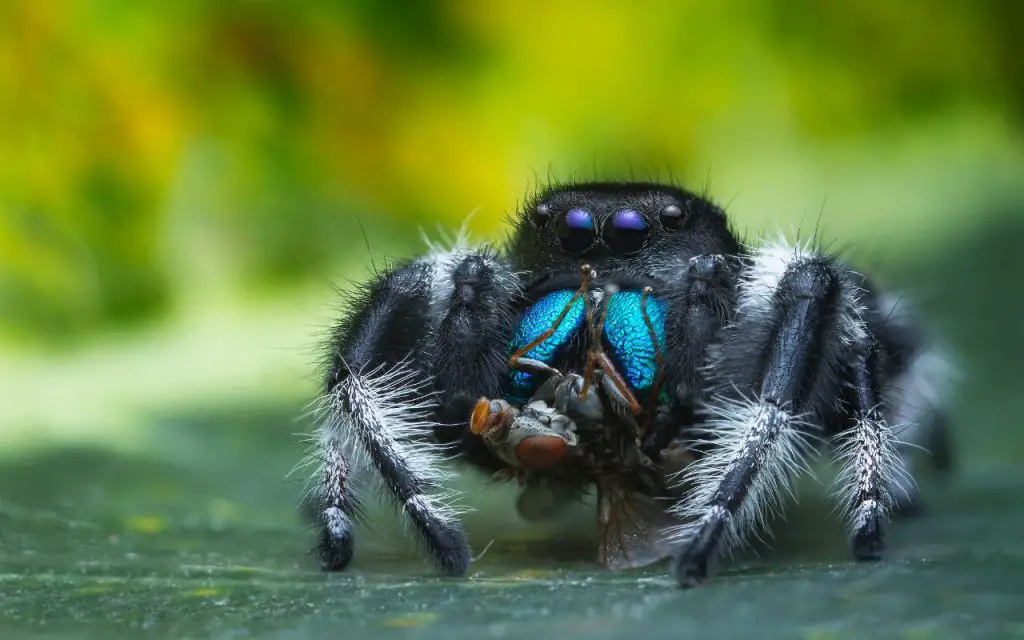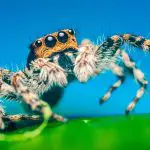Last updated on July 4th, 2023 at 10:14 am
Are jumping spiders nocturnal? Whilst most spiders are indeed nocturnal, the Salticidae, or jumping spiders, seem to be an exception…
If you have ever watched a jumping spider in your yard, you may be wondering, are jumping spiders nocturnal? These spiders hunt their prey during the day, which makes them easy to spot. Around the world and accross all known species, jumping spiders are always diurnal – not nocturnal.
Are jumping spiders nocturnal?
While most jumping spider species are carnivores, some species of them include nectar in their diet. Bagheera kiplingi is a notable example. While it primarily feeds on plant matter, it is known to eat invertebrates too.
The species Bagheera kiplingi is an omnivore, eating the Beltian bodies (like little buds) of a type of mimosa tree. That said, even this bizarre species is not just as diurnal as the rest.
Jumping spiders live in a variety of habitats. They are not nocturnal. They are most active during the day, and their eyes are placed near the front, a characteristic of animals that hunt by sight.
Instead of spinning webs to wait for food, jumping spiders pounce on prey and inject venom. These spiders are often found on windowsills, plants, and clothing. They’re great for pest control, but the spider poses no danger to humans.
These spiders are excellent hunters, and they prefer the sunshine to the darkness. Their jumping ability is unsurpassed, and they are able to leap many times their own body length!
Jumping spiders often tether their silk before jumping, which protects them from falling and helps them land back on their feet safely. So, if you see a jumping spider leap off of something, don’t worry – it knows what it’s doing.

How long do jumping spiders sleep?
Jumping spiders use nocturnal resting as a protection strategy, as they don’t always have access to light during the night. Instead of resting in a typical web, they often curl over a leaf, and use their silk to make it into a tubular nest that is safe from predators. On occasion, they also do this in cracks in walls or tree bark.
During the day, jumping spiders use their four pairs of eyes to detect their prey and then leap to catch them. The gorilla jumping spider, for example, hangs by a single thread in mid-air for hours, and researchers think that it uses vibrations to alert its prey. Whether this is an actual behavior or a warning, it’s fascinating to learn about these amazing creatures. And if you want to learn more about these amazing creatures, there’s only one thing you need to do: visit our website today!
If you’ve ever wondered how long spiders sleep, you’re in luck. Spiders sleep differently than humans do. Instead of lying down to rest, they have daily activity cycles.
These cycles also help spiders conserve energy by reducing their metabolic rate and activity level. The latter is more efficient as they don’t need to work as hard and rely on their prey to feed on.
For diurnal species like jumping spiders, the activity time is for all daylight hours, and the rest part of the cycle is all night time hours. So these species sleep for up to 12 hours, depending on when dawn and dusk are.

Do jumping spiders come out at night?
Do jumping spiders come out at night? This is a question often asked by homeowners. These spiders don’t live in enclosed shelters. Instead, they move around like one-man bands.
Male jumping spiders often drum on the ground and rub their body parts together in order to attract females. According to a research project by Damian Elias, who studies the mating behavior of jumping spiders, the males try to attract females by mimicking the movement of ants. If the female has matured, the male will mate with her and start a new nest.
Jumping spiders have four pairs of eyes. They have large front eyes and smaller eyes on each side. They also have large eyes located on their heads. The four sets of eyes help them track prey.
At the same time they use their peepers to judge the dance movements of males. Surprising though, these little guys prefer to hunt in daylight – despite having powerful vision. So, in general, you won’t see jumping spiders at night.
There is one exception though, and that is if you have outdoor lights that attract bugs. Sometimes, jumpings spiders will gather around these to catch a meal, as the light allows them to see.

Do jumping spiders need light at night?
Unlike most creatures, jumping spiders can see in dark and green light. In fact, they have better vision than many other arthropod species, including dragonflies. I
In one study, researchers in Japan have demonstrated that jumping spiders can improve their depth perception by bathing in green light. The spiders made accurate jumps toward prey, while those in red light consistently missed their prey. These findings suggest that spiders can see in dark and green light, but may not require light at night.
While nocturnal animals need light, jumping spiders have multi-purpose eyes. Their secondary eyes are more sensitive to green light than human eyes, allowing them to see in dark environments. They use their secondary eyes to hunt prey and scout for prey, even at night.
That said, just because jumping spiders can see at night, doesn’t mean that they like to come out at night. Captive Salticidae do not need light at night, and most of the time will spend the whole night resting.

Are jumping spiders active during the day?
Jumping spiders are always active during the day. Rather than builds webs to catch their prey, they actively track it and pounce on it using their excellent eyesight.
In fact, this acrobatic spider is capable of seeing patterns better than either a lion or an elephant. This ability is due in large part to the spider’s four pairs of eyes, which are arranged in a forward-facing position.
Its central eyes function for sharp vision, while its other pairs are used for peripheral vision. It’s also important to note that its retinas can change color, which enables the spider to detect different segments of the world.
Think of these spiders – known as the Salticidae – as tiny little apex predators. They are the tigers of the little bug world, attacking prey as large as themselves or larger, and using a lot of energy and activity to do so.
The body of a jumping spider is compact and robust with eight legs. These legs can generate pressure using body fluids to jump and catch their prey.
While some spiders breathe through either specialized lungs in the abdomen called book lungs or trachae (tubes), jumping spiders breath through both types of organ. This supplies additional oxygen to sustain their sudden activity.
However, jumping spiders are not dangerous to humans. This makes them a great pet for children, and you may find them living in your yard or attic do some free pest control for you.

What do jumping spiders do at night?
Some European jumping spiders spend the night hanging from a silk thread. One such species is the palearctic Evarcha arcuata, or Metallic Jumper. It seems as though they are using the thread as a bungee cord, but that’s not necessarily the case. The truth is that scientists aren’t entirely certain why they do so.
This type of behavior isn’t the norm for jumpers around the world, though. Most of them prefer a sheltered place to spend the night. Regal Jumpers are known to do this, for example.
Jumping spiders aren’t known to build webs, but they do use silken shelter to protect themselves and their eggs. At night, many of them turn over a leaf and bind it together with silk for a nest, or occupy a snug crack in a wall.
All in all, it seems jumpers have four main ways of sleeping at night:
- Making a silk nest in a leaf
- Making a silk sac, in a crevice or wall
- Hanging in mid air
- Resting on a leaf without making any kind of nest (less common)

Do jumping spiders burrow?
People who’ve kept tarantulas or trapdoor spiders may be wondering, do jumping spiders burrow too? The answer is definitely no – burrowing is not part of their lifestyle.
What all jumpers have in common is that they stalk prey by sight, and rely on their jump to catch it by surprise. They do not wait in ambush at the entrance to a burrow like some of spiders.
Jumping spiders are characterized by their unique body shape, which has a rectangular appearance. They have two large eyes in the middle of their head, and four smaller ones in the front. These small eyes are for focusing and provide peripheral vision, while the large primary eyes provide massive color detail and spatial acuity.
Jumping spiders are members of the family Salticidae, which has over 6,200 described species and 600 recognized genera. The diversity of these spiders is incredible, as they use both systems of breathing to hunt for prey.
In addition to their iridescent chelicerae, they’re often brightly colored. This is because they’re able to hunt vertically and inversely, and aren’t confined to one type of habitat. They are always visible, and need warning coloration to frighten potential predators.
The precision of spiders’ jumps differs. In some situations, they overshoot the edge of the landing platform, due to a reduction in visual capability. Other circumstances, such as when the jump distance increases, they overshoot.

Can jumping spiders see in the dark?
The eye of a jumping spider is like a Galilean telescope: a long tube, filled with gel, sits under the lenses. The light is bent as it travels down the tube, spread out, and enlarges before hitting the spider’s retina. When a jumping spider wants to see something, a muscular system in the retina enables it to change its point of view.
Researchers have studied the eyes of jumping spiders to determine how they view the world. They studied mating dances and dissected the spider’s eyes to examine the wavelengths absorbed by the inner pigments.
Jumping spiders have two pigments for green and UV light, as well as a red filter pigment. These pigments are responsible for guiding the main eyes to view different colors. In contrast, human eyes have only a narrow field of view.
It is thought that the green pigments do allow jumping spiders to see in the dark. So, technically yes, they can see in the dark – but they don’t come out at night.
In spite of this, spiders use their keen eyesight to hunt, not their web. Jumping spiders are also equipped with telescopic eyes at the sides of their heads. The “looming response” is used to recognize danger by detecting motion.
This response is absent in humans, as each of our eyes only has one pair of photo-receptors. In contrast, spiders have multiple pairs of eyes, allowing them to detect more colors than human eyes can distinguish.







